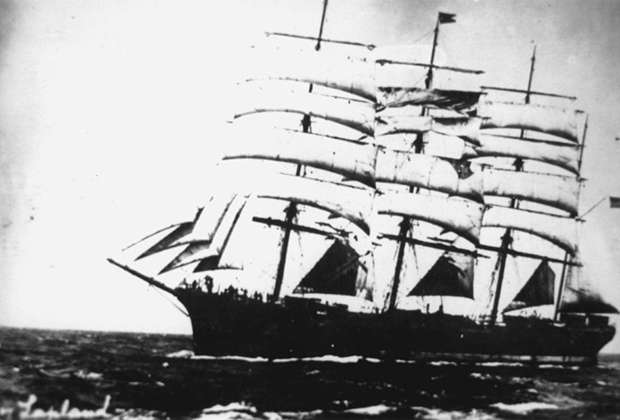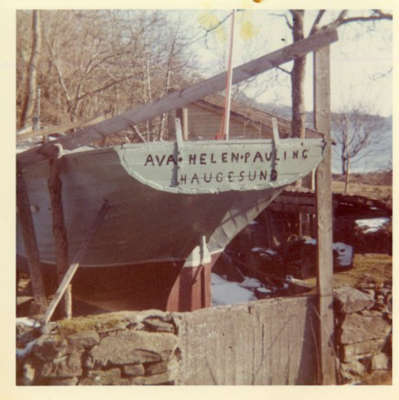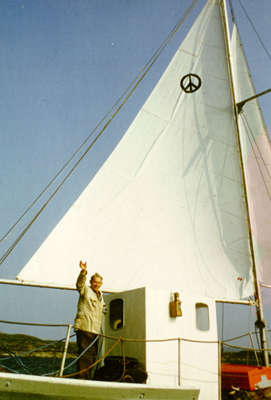Anders Janius Smedsvik, a sailor from Norway, a committed communist and pacifist, who survived hurricanes and shipwrecks, passionately dreamed of world peace. He built a non-motorized sailing ship with his own hands and set out to conquer the Atlantic Ocean, trying to prevent a nuclear war. But the authorities put obstacles to the idealist sailor. Realizing that his dream was not destined to come true, the lonely wanderer managed to trick him into the open ocean for the last time and then disappeared without a trace. An exciting and tragic story of his life is in the material of “Lenta.ru”.
Thrust to the sea
Anders Janius Smedsvik was born on October 14, 1885 on the Norwegian island of Hasseloy. His father Jacob worked all his life on a steamer and rose to the rank of captain. The maternal grandfather was also a sailor, so Smedswick inherited the desire to conquer the oceans.
The boy had almost no childhood. The family lived in poverty, besides, his mother, a housewife, gave birth to new children almost every year. Most of them died in early childhood. When Smedswick was five years old, his mother also died.
At the age of 13, the young Norwegian independently went to the German city of Hamburg and got a job on the sailing ship “Morna”. The team dumped the dirtiest work on the young man and beat him for the slightest offense.
One night during a storm, sailors lifted the unfortunate Smedswick to the mast in order to take the reef – to reduce the sail area and thereby stabilize the ship. The young man was sick all night. “By the way, I'm lucky. After that, I never had seasickness, “the Norwegian later admitted.
In two difficult years at sea, Smedsvik managed to earn one hundred NOK. Then he left for the German city of Bremerhaven, where he bought a new suit for 33 crowns and a return ticket home.
The suit did not pay for itself – after two weeks the young man again went to sea. He got a job on the steamer Sieggen, and during the voyages the whole modern history passed before the young man. When Smedswick was transporting coal to the German city of Kiel, he saw the yachts of Nicholas II and Edward VII, and near the Canary Islands he noticed an American ship with lowered sails due to mourning for the shot of President William McKinley.

Photo: Picture alliance / Contributor / Getty Images
But it all ends someday, and the steamer returned to the Norwegian Haugesund. The 15-year-old boy did not stay on the shore for long: he got a job on another steamer. For the next five years, he walked off the coast of Algeria and India, learning to hunt turtles and learning marine science.
At the age of 20, Smedsvik passed the exam for the assistant in command of the ship and then began to build a career: he decided to get a job as the second assistant to the captain on the sailing ship Norden, because he learned that the sailors were not paid and were fed spoiled food.
The young man received a position, and while sailing, in a storm, he staged a riot and actually seized power in order to eliminate injustice. Then, in 1905, the Norwegian, by his own admission, began to identify himself as a socialist and communist: he was outraged by the bestial treatment of shipowners with ordinary members of the crew.
In subsequent years, it is not easy to trace his fate, but it is known that from about 1910 to 1920 Smedswick lived in the American state of Oregon, where he changed many jobs: he managed to stay as a shepherd, cowboy and railroad worker. And, of course, he periodically went sailing.
Later, the Norwegian told the children that he was supposed to be on board the Titanic as a guest of the captain. However, by a lucky coincidence, the sailor slept and did not manage to get by train to the English city of Southampton, from where the ship departed on its first and only voyage. It is not very clear how he suddenly ended up on the other side of the Atlantic in 1912, but his grandchildren keep this family tradition.
Nellie
While Smedswick lived in America, he found a wife to match. A girl named Nellie combined many talents: she worked on a farm and skillfully shot at crows with a rifle, but at the same time knew five languages, played the piano and even received a bachelor's degree from a local college.
Life was not easy for the sailor's wife. During the First World War, Nelly read in the newspapers that her husband's ship had sunk off the coast of India. This was not so, but the unfortunate woman found out the truth only when her husband was able to contact her.
Smedswick later recalled that when Nelly met him at the train station, she looked like a living skeleton. The wife quietly but firmly stated that he could travel wherever he wanted, but only on the condition that she would always be with him. Moved to the core, the Norwegian fulfilled her condition. In all the years of wandering, Nellie never had seasickness, and she retained an iron composure even during the worst storms.
After World War I, Smedswick was promoted to captain with a monthly salary of $ 600. During those years he was in charge of several of the world's largest sailing ships, including the 100-meter Star of Lapland.

“Star of Lapland”. Photo: Public domain
He lived in luxury hotels and did not deny himself anything. When Smedswick was on an excursion at the White House, he was asked to meet with President Warren Harding, but the sailor refused. He noted that he had already seen the politician on the street in the car and was not impressed: Harding reminded him of a “third-rate lawyer.”
Over time, the sailor and his wife had three children. In 1923 the family moved to Norway. There they kept a farm, raised children and from time to time went sailing. Their idyll ended when World War II broke out and Nelly was diagnosed with cancer.
In September 1944, Smedswick was arrested for his communist views and placed in the Bergen-Belsen concentration camp. Despite the fact that Nellie was already very weak due to a long illness, she managed to get through to her husband and give him food. Until the last days, she remained a faithful military friend to him. “She's the most amazing person I've ever met,” Smedswick later admitted.
The Norwegian could not say the last goodbye to his wife. When she died, he was still a prisoner in a concentration camp. Smedswick remembered and loved Nelly to the very end. There were no other women in his life.
After the war
When Smedswick was released from the concentration camp, he returned to the village of Skjeld, sold the house in which he lived with his wife, and built a small hut.
Due to communist beliefs and active social activities, he was not allowed to continue his career as a captain. In the 1960s, he submitted several job applications and found himself blacklisted. “Because of my views. They made it clear to me, ”the man said in 1971 in an interview with a local newspaper.
By the way, in 1957, Smedswick quit the ranks of the Communist Party, because he was against the massacres that were perpetrated by the red leaders in different fears of the world. However, he continued to believe in the precepts of communism and remained a pacifist until the end of his days.
Smedswick took up farming. He began to grow fruit trees and keep livestock. He was considered the main sheep breeder and milk supplier in the village. In addition, the lone sailor produced cider for the Norwegian state-owned spirits company Vinmonopolet. He was one of the first to bring electricity to the hut.
The man ate fresh vegetables and oranges and did exercises every morning. Even at the age of 70, he had a thick head of hair and a youthful face, the people around him gave him a maximum of 50 years.
It was rumored that, despite his advanced age, he could walk eight kilometers up the hills just to buy and drink a cup of coffee. When going to the store, he put on a dark coat, took with him a backpack and a black hat, and went on a 56-kilometer hike.
According to the local church head, the sailor was wary of alcohol. While working as a cowboy and railroad worker in the United States, he allegedly met Jack London and saw with his own eyes how alcohol slowly killed a talented writer.
The sailor claimed that he was ill only once: being for the first time in the eastern part of India, he fell ill with malaria. At 86, Smedswick claimed to be as healthy as a bull.
The navigator lived in Spartan conditions. The house of 20 square meters had one room, which served the lonely owner at the same time as a living room, bedroom, and workshop. The hut had a telephone on which the man often called officials and fought over the size of his pension, as well as a typewriter on which he wrote articles for a local newspaper.
He liked to spend his free time reading. The entire space, except for the chairs, sofa, and floor, was littered with foreign books, newspapers, and magazines. Among them, of course, were the works of Karl Marx.
Sailboat
In December 1963, Smedswick heard the speech of the chemist Linus Pauling, who received the Nobel Peace Prize in 1962 as the author of the draft nuclear test ban treaty, and then the speech of his wife – social activist Ava Helen Pauling – thanks to which the scientist, by his own admission, and became interested in the topic of nuclear disarmament. Her words inspired the Norwegian. He realized that it is not enough to write articles for newspapers about the importance of world peace; you need to do something global so that the newspapers write about him.

American chemist Linus Pauling. Photo: Globallookpress.com
Then Smedswick conceived his circumnavigation of the world. The pensioner started building an 11-meter non-motorized sailboat according to his own drawings. On the sail, he painted the international symbol of peace, the Pacific.
Some said that when modeling the Norwegian was inspired by the American rescue ship, while others believed that he had built an analogue of a fishing vessel, which he once saw off the coast of the Canadian island of Newfoundland.
The sailor equipped the boat with a Bermuda sail and operated the vessel, which had no electricity on board, using two short ropes. He named his creation “Ava Helen Pauling”. It took five years to build the sailboat.
The Norwegian told reporters that his voyage was a protest against French nuclear bomb tests. However, the locals who knew him call other versions. Someone said that Smedswick was obsessed with the idea of getting to Cuba and meeting with Fidel Castro, others – that he was heading for the Gulf of Tonkin, where he was going to anchor off the coast of Vietnam and protect Hanoi from American bombing: he allegedly hoped that the military would be afraid offend a citizen of a NATO member country.
On June 30, 1972, a few months before his 87th birthday, Smedswick sailed from Carmey Island. Setting course towards the Norwegian capital, Oslo, he tuned in a small road radio and listened to a favorable forecast for western Norway from the meteorological institute.
Be that as it may, on June 30, 1972, the 86-year-old captain of the Ava Helen Pauling hit the road. At first, the weather conditions favored Smedswick, and his mood was excellent. He planned his first stop in the French city of Le Havre. There he was going to meet with an old acquaintance and wait for a fair wind.
Then he planned to bypass the Bay of Biscay, catch the northeastern trade winds south of Gibraltar in sails, pass the Azores, cross the Atlantic and enter the Caribbean. There, load with provisions in Barbados, the Bahamas and, possibly, Cuba, and then go through the Panama Canal to the Pacific Ocean.
After that, the plans included possible stops in Hawaii and Japan, and then – a transition to the Indian Ocean through the Malay archipelago. Since the Suez Canal was closed, Smedsvik had to go around Africa, and then follow the trade winds and return to Europe. According to his calculations, he should have been in Norway again in seven to eight months.
As a navigator dreamed of, his risky journey was covered in local newspapers. The first stage of the journey was to take 10 days. When, six days after sailing, the sailor was not found in the North Sea, journalists sounded the alarm. In the following days, weather conditions also did not favor his plans. “We hope he's okay. Anders Smedsvik is a seasoned sailor who monitors the wind and weather conditions, ”wrote the newspaper of the Haugesund commune.
After ten days the weather improved, but Smedswick could not be found. The search for the lone wanderer was taken up by employees of an oil supply base in the North Sea and the coastguards of Great Britain and France on patrol boats and helicopters. Soon, two weeks had passed since the sailing ship Ava Helen Pauling left the coast of Norway, and there was still no news.
Traces of Smedswick were lost, but the locals did not lose hope of a successful outcome: they knew that the sailor survived in much harsher conditions than the powerful wind in the North Sea. He went to sea for many years and became one of the few Norwegians who managed to sail around Cape Horn in Chile. He survived as a vagabond in Tasmania, a rebel in the Atlantic Ocean, and a deserter in Mauritius. The sailor coped with hurricanes in all oceans of the world and escaped from shipwrecks.

Ava Helen Pauling. Photo: dagbladet.no Not a tailwind
On July 16, 1972, a lighthouse keeper on the Dutch island of Terschelling looked south and noticed a small ship a few kilometers offshore. When no one appeared on deck the next day, the caretaker contacted the search and rescue services, who went to check if the crew needed help.
As they swam closer, the rescue team saw that a symbol of peace was painted on the sail, and an American woman's name was written on the stern. The boat's hull was damaged and the sail was torn.
Anders Smedswick, drenched and exhausted, was found on board. When he came to his senses, the first thing he did was ask: “Did I get to the French city of Le Havre?” He later explained in an interview with a Norwegian newspaper what had happened.
It turned out that after two days of serene sailing he got into a weak but growing storm. The wind tore one of the Ava Helen Pauling's sails, but Smedswick continued on, heading west. According to him, the ship could still move forward, but did not pick up the required speed.
Eventually he noticed the coastline of England. But the waves were too strong and did not allow the sailor to reach the British coast. When the wind died down, the boat began to drift uncontrollably in the water. Later, Smedswick caught the northwest wind and managed to swim to Terschelling. Once broke, he went down to the cabin to wait out the night, after which the search team found him.
For what happened, he refused to blame the “Ava Helen Pauling”, calling her an impeccable ship for sea travel. The sailor believed that only the wind prevented the trip. When asked by journalists if he was going to continue sailing, he answered without hesitation: “Yes. Don't even doubt it. “
Ban
Soon Smedswick appeared on the front page of the largest newspaper in the Netherlands, announcing that, as soon as the Ava Helen Pauling was repaired, he would continue sailing as a protest against the French nuclear program. The news caused concern among Norwegian diplomats. The case was transferred to the Ministry of Foreign Affairs, and the Norwegian vice-consul in Terschelling, Jan Douksen, was instructed to persuade the sailor to return to his homeland.
Dawsen began to dissuade the sailor from the plan to cross the Atlantic Ocean and confiscated the lanterns and other equipment from Smedswick's sailboat so that he would not go to sea. With the support of the consulate, the diplomat bought the sailor new clothes and promised to organize the most comfortable return home for him. The man was temporarily placed in a three-star Oepkes hotel.
As the hotel was full, Smedswick had to sleep behind the curtains in the attic. The guest was surrounded by care, but he did not like captivity, and he also had no desire to talk about himself. He was going to go to protests in France as soon as possible. Other guests recall that he ate a lot, but avoided rice – this cereal was his main diet while swimming.

Anders Smedswick on his sailboat. Photo: dagbladet.no
As soon as the Ava Helen Pauling was towed to the shore of Terschelling, Smedswick began to disappear day and night aboard the sailboat. As the sailor repaired the ship, trying to make it navigable, the pressure from the Norwegian authorities grew. The police tried to influence the children and old comrades of the sailor to force him to return home.
The efforts of Douxen and his team were crowned with success, and the Norwegian ultimately surrendered. His dream was trampled, there was almost no money left, but the gaze from under the hat pulled down over his eyes remained the same firm.
Having obediently returned to his homeland, the sailor sat down to write his autobiography. This was already the third attempt. The first manuscript was lost when he sold his house after the war, and the second drafts with the story of Smedswick's life were stolen on the train.
Burned down
In the spring of 1974, the sailor turned 88 years old. By that time, he had almost finished working on his autobiography and, according to local newspapers, found publishers willing to publish the manuscript.
April was dry, and Smedswick's hut was built of wood. There was a stove with a chimney in the house, and on the last Sunday in April, at about 9:30 am, a man noticed that the stove was smoking unnaturally. He went outside to inspect the chimney, and noticed smoke billowing from the walls. The Norwegian grabbed a bucket and tried to flood the fire with water, but it was too late.
Then he ran into the house to call the fire department, but it was already too late: the hut was enveloped in flames. The man could only watch as everything that he had amassed over the decades burned to the ground: furniture, newspapers, books, magazines and, most valuable, a description of his amazing life.
When the flames were extinguished, the sailor was left with only one valuable thing – the sailing ship “Ava Helen Pauling”, which was still standing in Terschelling.
Sailed to nowhere
After the fire, Smedswick moved in with his granddaughter Jenny Lofsberg. One summer morning, she woke up to find that her grandfather had disappeared without saying goodbye. The mother explained to her that the itinerant relative had gone to the Netherlands.
Smedswick's neighbor, Waldemar Skogland, said that shortly before the comrade's last journey, they walked with him and saw a funeral procession. The sailor looked at her and said, “I don't want to end like this.” And then he burst out laughing.
When the Norwegian reached Terschelling, he could not even raise the anchor. The sea wolf, which neither storms nor waves could break, was defeated by bureaucracy and fire. According to relatives, he passed very quickly.
The diplomats banned the sailor from taking the Ava Helen Pauling out of the harbor and again began to persuade him to return to his homeland. Smedswick was sent back to the Oepkes Hotel. According to the owners, he kept a crystal clear sanity, but was terribly angry that he was not allowed to sail.
On the night of August 29, 1974, a strong wind rose on the island. The weather conditions were just disgusting. Norwegian diplomats and port patrols were asleep, so no one noticed the quiet, unpowered sailing ship slowly emerge from the harbor. The inhabitants of the island still wonder how the sailor managed to unnoticeably turn his plan.
No one knew where Smedswick had gone or why. “Is he heading for Cuba?” – asked journalists of local newspapers. The grandchildren assumed that the grandfather could have gone to Hasseloy Island, where he was born.
However, several people who knew the sailor well said that he was a rational person and should have realized that he could not sail across the North Sea in stormy weather. Of course, he could believe and hope, but not likely. They also knew that Smedswick was definitely not one of those who would be frightened by death at sea.
The end of his amazing life will forever remain a mystery. Only one thing is known: on that stormy night, Smedswick alone stood at the helm of the Ava Helen Pauling and went out into the open ocean, disappearing forever. Neither the sailor nor his sailboat was ever found.

